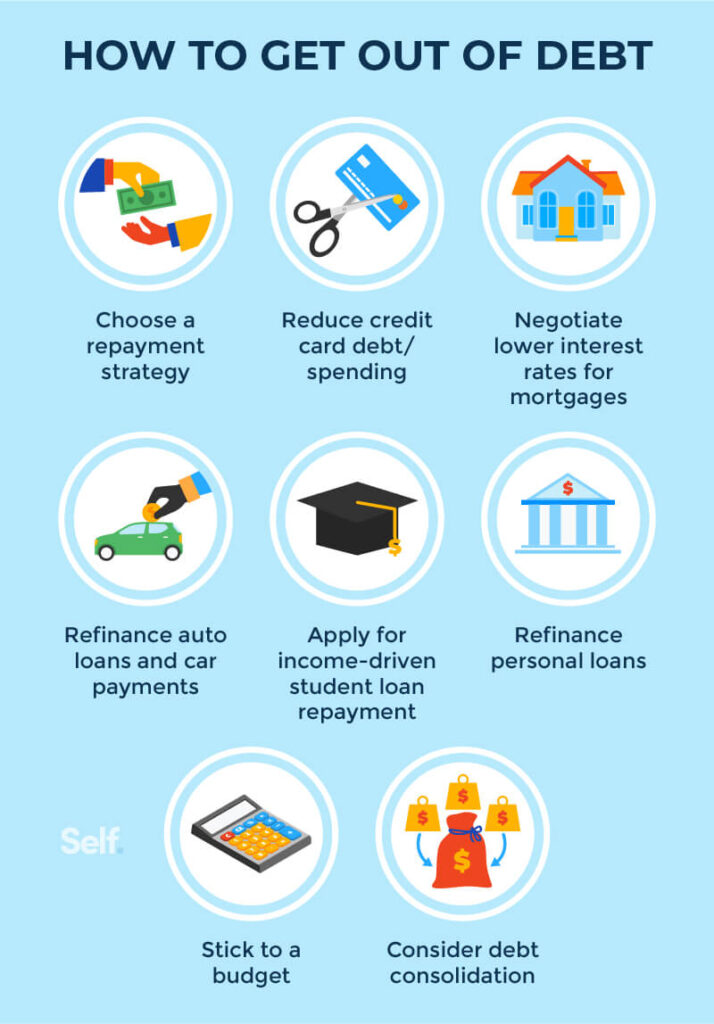
🧾 Tips to Get Out of Debt: Proven Strategies and Tools to Regain Financial Freedom
Debt can feel overwhelming and stressful, but getting out of it is absolutely possible with the right strategies and mindset. Whether you’re dealing with credit card balances, personal loans, or other debts, understanding how to organize and tackle your debt efficiently can save you money, reduce stress, and improve your financial health.
In this article, we’ll explore practical tips and proven methods like the debt snowball and debt avalanche, as well as useful tools that can help you reorganize your debt and make a solid plan to become debt-free.
Understanding Your Debt Situation
Before jumping into repayment strategies, it’s important to have a clear picture of your total debt. Here are some steps to get started:
- List all debts: Include credit cards, loans, medical bills, and any other outstanding balances.
- Record details: Note each debt’s balance, interest rate, minimum monthly payment, and due date.
- Calculate your total monthly payments: This helps you understand your cash flow needs.
- Know your income: Be realistic about how much you can allocate towards debt repayment after essential expenses.
Once you have a comprehensive overview, you can decide which strategy works best for you.
Debt Repayment Strategies
1. The Debt Snowball Method
The debt snowball method focuses on paying off your smallest debt first, regardless of the interest rate. Here’s how it works:
- List your debts from smallest balance to largest.
- Continue paying minimum payments on all debts.
- Put any extra money towards the smallest debt until it’s paid off.
- Once the smallest debt is paid, roll its payment amount into the next smallest debt.
- Repeat until all debts are cleared.
Why use the snowball method?
This strategy provides quick wins by eliminating small debts early. These victories build motivation and momentum to keep going.
Example:
If you owe $500 on one card and $3,000 on another, focus on the $500 first. When it’s paid, use the money you were paying on it to attack the $3,000 debt.
2. The Debt Avalanche Method
The debt avalanche method prioritizes paying off debts with the highest interest rates first. The steps are:
- List your debts from highest to lowest interest rate.
- Pay minimum payments on all debts.
- Allocate any extra money toward the debt with the highest interest.
- After paying off the highest-interest debt, move on to the next highest.
- Continue until all debts are fully repaid.
Why use the avalanche method?
It saves you the most money in interest payments over time, making it financially optimal.
Example:
If one loan has a 20% interest rate and another 10%, attack the 20% debt first to reduce overall interest costs.
Which Method Should You Choose?
Both the snowball and avalanche methods work well, but your choice depends on your personality and priorities:
- If you need motivation and quick wins: The snowball method is great to build momentum.
- If saving money on interest is your top goal: The avalanche method is the more cost-effective strategy.
You can also combine both—start with the snowball for motivation, then switch to avalanche once you feel confident.
Tools to Help You Reorganize and Manage Your Debt
Managing multiple debts can get complicated, but several tools and apps can help simplify the process:
1. Debt Repayment Calculators
Many websites offer free calculators where you input your debts, interest rates, and payments to create a personalized payoff plan. These calculators show how long it will take to become debt-free and how much interest you’ll save with different strategies.
2. Budgeting Apps
Apps like Mint, YNAB (You Need a Budget), or EveryDollar help you track income, expenses, and debt payments in one place. These tools encourage discipline and help you stick to your repayment plan.
3. Debt Management Apps
Apps such as Undebt.it or Tally specialize in debt management. They allow you to organize debts, set payment priorities, and send reminders, making it easier to stay on track.
4. Debt Consolidation Services
If you have multiple high-interest debts, debt consolidation might be an option. This involves taking out a new loan with a lower interest rate to pay off all your debts, leaving you with just one monthly payment. Be cautious and research thoroughly before choosing this path.
Additional Tips to Accelerate Your Debt Repayment
- Cut unnecessary expenses: Identify spending areas you can reduce and redirect that money toward debt.
- Increase your income: Consider side gigs or selling unused items to boost repayment funds.
- Negotiate with creditors: Sometimes creditors can lower your interest rates or offer hardship programs.
- Avoid new debt: Don’t add to your balances while repaying existing debt.
- Automate payments: Set automatic transfers to avoid missed or late payments.
The Psychological Side of Debt
Getting out of debt isn’t just a numbers game—it also requires managing stress and maintaining motivation:
- Celebrate milestones to keep morale high.
- Join support groups or forums for encouragement.
- Keep a positive mindset and focus on the freedom debt repayment will bring.
Conclusion: Take Control of Your Debt and Your Life
Debt can feel like a heavy burden, but with clear strategies like the snowball and avalanche methods, and helpful tools for organization and budgeting, you can regain control of your finances. The key is to start now, be consistent, and stay committed.
Remember, every dollar you put toward debt repayment is a step closer to financial freedom and peace of mind. Use the tips and resources outlined here, and you’ll be on your way to a debt-free future.
